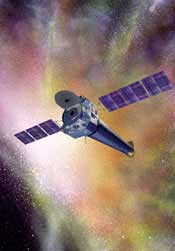Quark star glimmers

Space telescope may have spotted strange matter. <br>© NASA/Chandra <br>
Astronomers may have discovered a strange new form of matter.
Astronomers think they might have spotted a quark star, a mass of fundamental particles only a few kilometres across but weighing more than our Sun. If the star’s nature is confirmed, it would be the first example of this state of matter.
Theoreticians hypothesized the existence of quark stars in the 1980s. Today, NASA announced the discovery of such a star, based on results from their space telescope the Chandra X-ray Observatory. The star, called RX J1856, is about 360 light years from Earth.
RX J1856 was previously thought to be a neutron star – these are formed when a large star explodes and collapses in on itself. Gravitational attraction between particles in an atom overcomes the electrical repulsion keeping them apart, fusing protons and electrons to form neutrons, which pack together at unimaginable density. A teaspoonful of neutron star would weigh a billion tons.
But Chandra’s measurements suggest that, at just over 11 kilometres across, RX J1856 is too small to be a neutron star, if current models are correct.
Instead, neutrons and protons in the star may themselves have dissolved into an even denser mass of their constituent quarks, suggests Jeremy Drake of the Harvard-Smithsonian Centre for Astrophysics in Cambridge, Massachusetts, and his colleagues1. This is known as strange matter, in which the packaging of three constituent quarks in a proton or neutron breaks down.
“Strange matter could be fairly common in the Universe,” says Drake. It should be stable, and might grow like a crystal from the neutrons and protons it encounters. It’s possible, he adds, that all neutron stars are in fact quark stars. Drake declares himself “unbiased” about the star’s true identity.
But astronomer Frederick Walter of the State University of New York, Stony Brook, argues that the announcement is premature. Our ignorance of the star’s temperature and chemical composition make its diameter uncertain, he says.
“If it’s a quark star it’s spectacular, but there’s absolutely no evidence for that,” Walter says. There is an alternative explanation: that variation in the star’s temperature makes it hard to estimate its diameter. The probability of this is less than 10%, as it would require the hottest part of the star to be pointing straight at Earth.
“These results are not definitive,” agrees Michael Turner, an astrophysicist at the University of Chicago. Studies of other bodies are needed to confirm whether quark stars really exist, he says.
Chandra’s observations do show how the extreme regions of space can be used to test physical theories, adds Turner. “We can use the Universe as a heavenly laboratory.”
References
- Drake, J. J. et al. Is RX J185635-375 a Quark Star?. Preprint, (2002).
Media Contact
All latest news from the category: Physics and Astronomy
This area deals with the fundamental laws and building blocks of nature and how they interact, the properties and the behavior of matter, and research into space and time and their structures.
innovations-report provides in-depth reports and articles on subjects such as astrophysics, laser technologies, nuclear, quantum, particle and solid-state physics, nanotechnologies, planetary research and findings (Mars, Venus) and developments related to the Hubble Telescope.
Newest articles

First-of-its-kind study uses remote sensing to monitor plastic debris in rivers and lakes
Remote sensing creates a cost-effective solution to monitoring plastic pollution. A first-of-its-kind study from researchers at the University of Minnesota Twin Cities shows how remote sensing can help monitor and…

Laser-based artificial neuron mimics nerve cell functions at lightning speed
With a processing speed a billion times faster than nature, chip-based laser neuron could help advance AI tasks such as pattern recognition and sequence prediction. Researchers have developed a laser-based…

Optimising the processing of plastic waste
Just one look in the yellow bin reveals a colourful jumble of different types of plastic. However, the purer and more uniform plastic waste is, the easier it is to…


